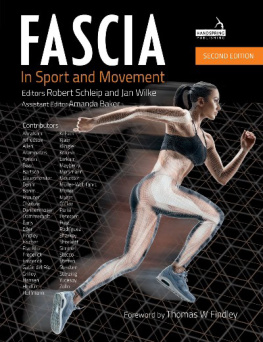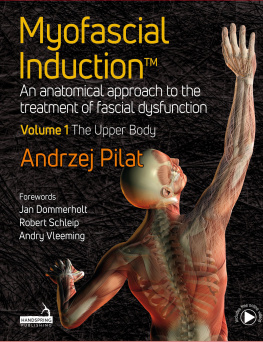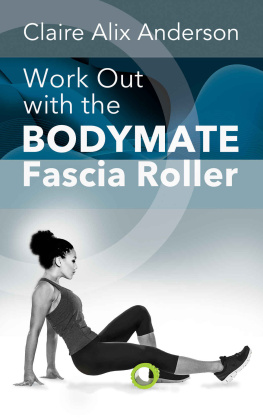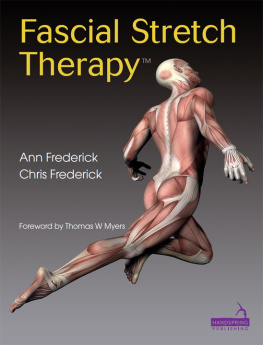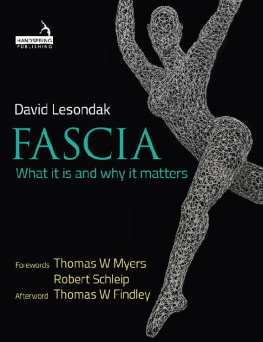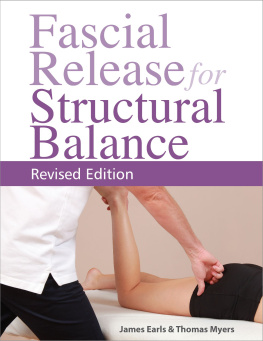Front Matter

FASCIAL
Fitness
Robert Schleip
with Johanna Bayer
2021 by riva Verlag, part of Mnchner Verlagsgruppe GmbH. All rights, especially the right of reproduction and distribution as well as translation, are reserved. No part of the publication may be reproduced in any form (by photocopying, microfilming or any other process) or saved, processed, copied or distributed by means of electronic systems without the written consent of the publisher.
The English language first edition first published in 2017. This second edition published in 2021 by
Lotus Publishing
Apple Tree Cottage, Inlands Road, Nutbourne, Chichester, PO18 8RJ
North Atlantic Books
Berkeley, California
Fascial Fitness: Practical Exercises to Stay Flexible, Active and Pain Free in Just 20 Minutes a Week, Second Edition , is sponsored and published by the Society for the Study of Native Arts and Sciences (dba North Atlantic Books), an educational nonprofit based in Berkeley, California, that collaborates with partners to develop cross-cultural perspectives; nurture holistic views of art, science, the humanities, and healing; and seed personal and global transformation by publishing work on the relationship of body, spirit, and nature.
North Atlantic Books publications are available through most bookstores. For further information, visit our website at www.northatlanticbooks.com or call 800-733-3000.
Important note
The content of this book has been researched and carefully verified to the best knowledge and belief of the authors and publisher, against sources they consider to be trustworthy. Nevertheless, this book is not intended as a substitute for individual fitness, nutritional and medical advice. If you wish to seek medical advice, please consult a qualified physician. The publisher and the authors shall not be liable for any negative effects directly or indirectly associated with the information given in this book.
Editor: Simone Fischer
Cover design: Pamela Machleidt
Cover images: Vukain Latinovi, Graphics: shutterstock/fox_industry
Models: Martina Meinl, Markus Rossmann
Layout: Medlar Publishing Solutions Pvt Ltd, India
Typesetting: Satzwerk Huber, Germering, Melanie Kitt, Lisa Killer
Printing: Replika Press, India
British Library of Cataloguing-in-Publication Data
A CIP record for this book is available from the British Library
ISBN 978 1 913088 21 7 (Lotus Publishing)
ISBN 978 1 62317 674 7 (North Atlantic Books)
Library of Congress Cataloguing-in-Publication Data
Names: Schleip, Robert, author. | Bayer, Johanna, other.
Title: Fascial fitness : practical exercises to stay flexible, active and pain free in just 20 minutes a week / Robert Schleip with Johanna Bayer.
Description: Second edition. | Berkeley : North Atlantic Books / Lotus Publishing, [2021] | The best-selling guide, expanded and revised -- title page. | Includes bibliographical references and index.
Identifiers: LCCN 2020054558 (print) | LCCN 2020054559 (ebook) | ISBN 9781623176747 (trade paperback) | ISBN 9781623176754 (ebook)
Subjects: LCSH: Fasciae (Anatomy) | Connective tissues. | Exercise. | Movement therapy.
Classification: LCC QM563 .S35 2021 (print) | LCC QM563 (ebook) | DDC 611/.74--dc23
LC record available at https://lccn.loc.gov/2020054558
LC ebook record available at https://lccn.loc.gov/2020054559
Robert Schleip
with Johanna Bayer
FASCIAL
FITNESS
Practical Exercises to Stay Flexible, Active and Pain Free in Just 20 Minutes a Week
Second Edition

Contents
Introduction:
Why you need to exercise your fascia
Chapter 1:
Fascia and connective tissue what are they?
Chapter 2:
The principles of fascia training
Chapter 3:
The exercises
Everyday life as an exercise:
making your movements more creative
Chapter 4:
Fascia, physiotherapy and gentle methods of recovery
Chapter 5:
Fascial fitness: healthy eating and lifestyle
Chapter 6:
Periodised fascia training for speed, power and injury resilience
Foreword
by Klaus Eder
When I was invited to write a foreword to this book in 2014, I couldnt possibly turn it down. Fascia is my favourite subject, and one that I have been dealing with throughout my entire career initially without knowing a great deal about it; only having a sense of its importance and noticing it during treatment. Thankfully thats all now changed, both for myself and almost everyone else in the same position especially since the publication of Fascial Fitness Dr Robert Schleip, which he wrote together with science author Johanna Bayer. This clear, concise book has become an essential resource and one that can be found on my own bookshelf and those of many of my colleagues. It is also something I often recommend to my patients and clients.
I hold the work of Robert Schleip in the highest possible regard, not least due to his commitment to sharing his practical knowledge and understanding of fascia. The two of us have long been united by a fascination with the role of fascia in the human body and how this affects us, especially in the field of sports medicine. Thanks to his research, along with his engagement in the field of physiotherapy, over the last 15 years Robert Schleip has succeeded not only in bringing fascia to the scientific community, but also in making it the focal point of sports physiotherapy and manual therapy. He also made the subject accessible to the general public and has proven himself to be a remarkable talent with his fascinating talks, seminars, workshops, training programs for amateur athletes and, of course, his best-selling books.
Words cannot express how happy I am that this clear, accessible book on fascia and fascial exercises has achieved so much success but with almost 80,000 copies sold, the numbers speak for themselves. Robert Schleip has succeeded in bringing the latest findings on fascia to the broadest of readerships, making it accessible to many different people.
The publication of these findings has also been just as beneficial if not more so to the professional field in which I have spent most of my career. I have been working with top athletes for the past few decades. These sportspeople trust me to look after their bodies. I have been taking care of the German national football team since 1988 and have supported our boys through eight World Cups, eight European Championships and ten Olympic Games. From 1990 until 2012, I was also in the fortunate position of working for the German Davis Cup tennis team as their physiotherapist. My approach to diagnosing and treating athletes is achieved using only my bare hands. This way, I get to know the consistency of most of the athletes muscles and fascia like the back of my own hand. I know only too well the major personal challenges players face when they have to retire temporarily or permanently as a result of injury or overused muscles and I can say with confidence that the fascia is almost always affected. In the majority of cases, I am able to reduce the severity of the pain and shorten their period of downtime. What helps me the most under these circumstances is my knowledge of fascial anatomy and my many years of experience as a physiotherapist.

At the Winter Olympics in Sochi in 2014, I also treated Bruno Banani, a luge athlete from Tonga.


